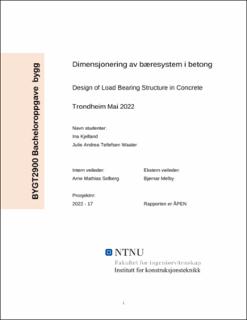| dc.contributor.advisor | Selberg, Arne Mathias | |
| dc.contributor.advisor | Melby, Bjørnar | |
| dc.contributor.author | Kjelland, Ina | |
| dc.contributor.author | Waaler, Julie Andrea Tellefsen | |
| dc.date.accessioned | 2022-07-05T17:20:47Z | |
| dc.date.available | 2022-07-05T17:20:47Z | |
| dc.date.issued | 2022 | |
| dc.identifier | no.ntnu:inspera:106805903:113577225 | |
| dc.identifier.uri | https://hdl.handle.net/11250/3002855 | |
| dc.description.abstract | Betong er verdens mest brukte byggemateriale. Det er mye brukt ettersom den har mange bruksområder og lang levetid. Betong tåler store trykkrefter, men tåler så godt som ingen strekk. Konstruksjoner av betong er derfor avhengige av armering i stål som tar opp strekk.
Denne bacheloroppgaven tar for seg dimensjonering av et bæresystem i betong. Oppgaven tar utgangspunkt i leilighetskomplekset «Privaten Sannan» i Steinkjer, prosjektert av Norsk Konstruksjonsrådgivning AS. Hensikten med oppgaven er å dimensjonere og kontrollere de ulike delene av et bæresystem, herunder dekke, vegg, søyle, bjelke og fundament. Det er også diskutert hvordan det kan brukes mindre materiale.
Gruppen valgte først statisk modell, for så å finne de opptredende lastene. Den statiske modellen består av rammekonstruksjoner med momentfrie hjørner. Tverrsnitt og lengder er hentet fra tegninger som gruppen fikk fra ekstern bedrift. Lastene som er tatt hensyn til i dimensjoneringen er egenlast, nyttelast, snølast og vindlast.
Alle konstruksjonsdelene er dimensjonert i brudd- og bruksgrensetilstand. I bruksgrense er nedbøyning, kryp, svinn, relaksasjon, riss og spenninger kontrollert. I bruddgrense er moment-, skjær- og aksialkapasitet, samt forankring og heft kontrollert. Dekket i bæresystemet er spennarmert, og kontrolleres på andre vilkår enn slakkarmerte konstruksjonskomponenter.
I diskusjonen har gruppen gjort rede for valgene som er tatt, og hva som kunne blitt gjort annerledes. Det er også diskutert mulige tiltak for å spare materiale i bæresystemet.
Dimensjoneringen resulterte i at oppgitte tverrsnitt var tilstrekkelige for å ta opp beregnede laster. Alle konstruksjonsdeler, med unntak av bjelken, kan armeres med minste armeringsmengde etter Eurokode 2. De fleste kontroller var innenfor krav, men armeringsspenningen i dekket var høyere enn tillatt.
Alle antagelser i beregningen er konservative, og det ble konkludert med at det er mulig å redusere armeringsmengde i betongen. | |
| dc.description.abstract | Concrete is the worlds most used building material. It is used due to its utilization and long lifespan. Concrete can withstand large compressive forces, but almost no tension. Concrete constructions are therefore dependent on reinforcement that withstand tension.
This Bachelor’s thesis addresses the design of a load-bearing structure of concrete. The thesis is based on the apartment building “Privaten Sannan” in Steinkjer, designed by Norsk Kontruksjonsrådgivning AS. The purpose of this thesis is to design and control the different load-bearing elements. It is also discussed how to cut back on materials.
The group first chose a static model, and then found the occurring loads. The static model consists of frameworks without bending moments in the corners. Cross-sections and spans are taken from drawings provided to the group by the external company. The loads included in the design are self-weight and loads because of service, snow, and wind.
The construction elements are designed for both Ultimate Limit State and Serviceability Limit State. For the Serviceability Limit State deflection, creep, shrinkage, cracks and stresses are controlled. For the Ultimate Limit State bending moment, shear, and axial capacity, along with the anchorage, are controlled. The slab contains post-tensioned reinforcement, which should be controlled based on other terms than the normal reinforcement.
In the discussion the group has accounted for the choices made, and what could have been done differently. The various measures to save material in the load-bearing structure are also discussed.
The result of the design was that the cross-sections were sufficient to accommodate the calculated loads. All structural parts, except the beam, can be reinforced with the minimum amount of reinforcement according to Eurocode 2. All the controls apart from the slab were within the requirements. The stress in the reinforcement in the slab was higher than permitted.
All assumptions in the calculation are conservative, and it was concluded that it is possible to reduce the amount of reinforcement in the concrete. | |
| dc.language | nob | |
| dc.publisher | NTNU | |
| dc.title | Dimensjonering av bæresystem i betong | |
| dc.type | Bachelor thesis | |
